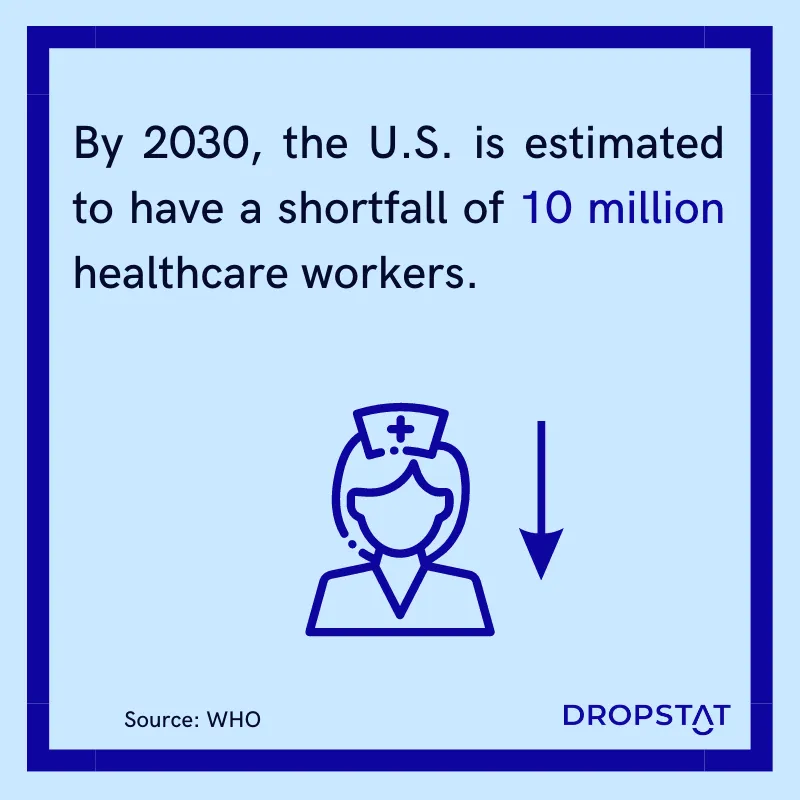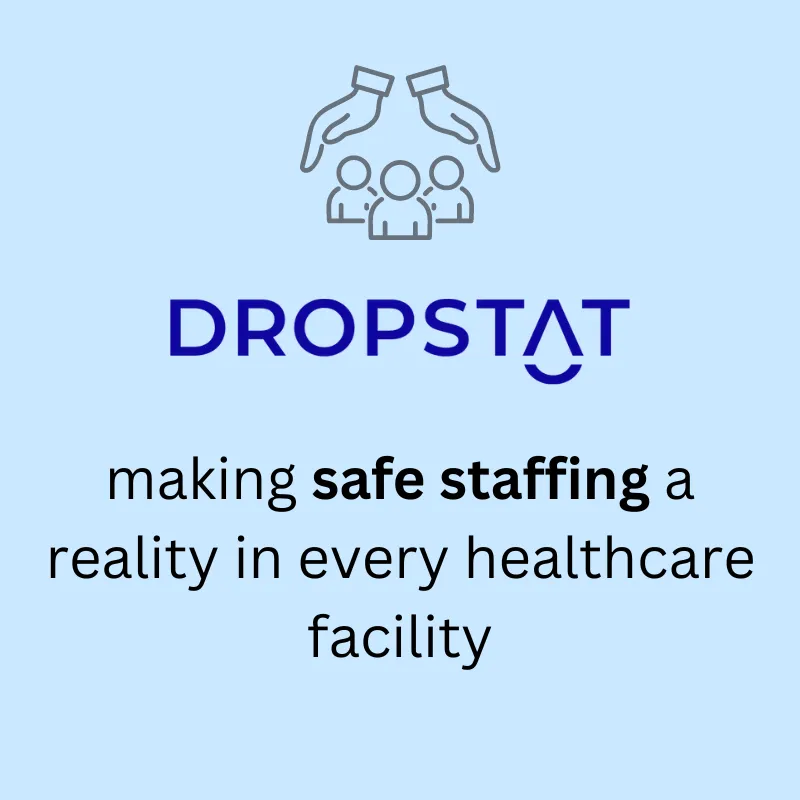Dropstat has successfully identified the common factors of staffing problems from working with many healthcare facilities of different sizes that have integrated Dropstat’s advanced workforce analytics systems.
8 key indicators of staffing challenges
The features that Dropstat has identified as indicators of facility staffing problems include:
- Your nurse-to-patient ratio is under 1:6
- The facility method of filling shifts involves the call-text-wait system
- Shifts do not have different competitive pay rates according to work hours (nights, weekends, holidays)
- Role inefficiency – unnecessary spending on overqualified or a lack of adequately qualified higher-level nurses
- Reactive hiring is a common practice in your facility
- Agency staff is regularly used instead of permanent staff for the same shifts
- Nursing bullying is repeatedly brought to the management’s attention
- Patient satisfaction is decreasing
1. Understaffed nurse-patient ratios
Although the optimum nurse-patient ratio was determined to be 1:4 in most situations, the increasing number of nurses leaving the profession and reaching retirement age has driven the ratio to 1:6. However, through Dropstat’s analytics, administrators are provided with real-time insights into the specific shifts that are lacking in staff as opposed to blindly hiring staff to fill the general shortage of nurses. This method allows management to understand where exactly more permanent staff is needed while also preventing extraneous spending.

2. The traditional call-text-wait system
The traditional way to fill open shifts is through manual communication from administrators and schedulers to staff. This has proved to be extremely inefficient, ineffective, and frustrating for both staff and administrators. When facilities use Dropstat, AI predicts staffing needs, automates shift communication, and auto-approves staff members based on safety, seniority, and cost efficiency. The Dropstat system streamlines communication and is faster, more reliable, and has a much higher shift-fill rate.
3. No shift differentiation compensation
Facilities that offer shift differential pay recognize the additional burden of shifts outside traditional working hours (like night shifts, holidays, and weekends) and provide additional compensation for staff who work those shifts. When staff is not compensated with competitive pay for these shifts, burnout rates tend to increase, increasing the likelihood that staff will seek other employment opportunities.
4. Role inefficiency
When facilities spend on higher-cost shifts for RNs, which could have safely been filled by an LPN, CNA, or another assistive nursing role, overspending becomes commonplace. By assessing which shifts could benefit from lower-level nurses as opposed to RNs, and filling those shifts accordingly, facilities save on unnecessary costs. Additionally, with this reduction of overspending on overqualification, healthcare facilities have the capability to increase the salary for LPNs and CNAs, which leads to improved retention and employee satisfaction as well.

5. Reactive hiring processes
In facilities with high turnover, administrators continuously look for new staff, often offering huge sign-on bonuses as an incentive. Even worse, reactive hiring does not focus on improving retention or satisfaction and feeds a vicious cycle. Rather than taking part in reactive hiring, management can focus on retention through proactive hiring, specifically by using Dropstat’s analytics to identify staff that may be displaying warning signs of turnover. This would enable administrators to put a greater effort into retention rather than attempts at last-minute hiring to compensate.
6. Recurring use of staffing agencies
Relying on staffing agencies to fill staffing deficits is expensive and creates added pressure on permanent staff to ensure that agency nurses understand the facility’s operations. Using a staffing agency also decreases patient satisfaction and safety as well as staff experience. Instead of depending on temporary workers, Dropstat pinpoints the holes in staff scheduling often filled by agencies to allow administrators to hire more permanent staff.
Dropstat has improved the facility’s hiring process by integrating with gig-economy platforms to reduce HR bottlenecks. By assessing employees’ skills through the work environment, new hires can evaluate whether or not they’re a good fit for the facility’s mission and goals. The predictive analytics used by Dropstat also enables hiring managers to screen resumes for the exact roles and necessary skills lacking in the facility.

7. Nurse bullying
The American Nurses Association defines nurse bullying as “repeated, unwanted, harmful actions intended to humiliate, offend, and cause distress in the recipient.” A culture of bullying within nursing increases the probability that your nurses will look for other employment opportunities. If these issues are not addressed, especially after repeated complaints, employees may lose faith in management to curb these issues.
Research has also found that around 85% of nurses experience bullying throughout their career showcasing how prevalent this is within the field. Ideally, hiring practices should seek out quality employees which would improve employee retention for both existing and new employees through improving company culture.
8. Patient satisfaction is decreasing
Ultimately, nursing staff satisfaction affects the quality of care that patients receive. When nursing departments are regularly working overtime, burnout becomes increasingly more likely, and the quality of care that nurses deliver suffers. In addition to excessively long shifts, when facilities do not hire enough permanent RNs, LPNs, and CNAs, each nurse has a larger caseload of patients. This dynamic limits the attention and time that each patient receives while decreasing the ability for nurses to rely on other members of the care team as they are overwhelmed with patients’ cases as well.

Dropstat enables facilities to limit overtime and hire the right nursing roles for each department by analyzing patterns in overtime and agency use. This allows administrators to preemptively pinpoint which staff are likely to experience burnout or feel dissatisfied with their roles. This prioritizes patient satisfaction by ensuring that each patient gets the maximum high-quality attention from the care team.
Dropstat’s methods of preventing staffing issues and improving job satisfaction
While many of the common staffing issues that facilities experience can be mitigated by the hiring manager, Dropstat aids in these processes. With its ability to analyze agency hires for specific nursing roles, Dropstat can determine which departments are not hiring employees efficiently and relying on expensive agency staff. This contributes to unnecessary costs and reduces the quality of patient care and outcomes.
Additionally, Dropstat’s platform enables administrators to track bonuses and shift rates, which leads to greater transparency in compensation and helps to increase retention in your facility by providing competitive and adequate salaries. This process also empowers facilities to determine staffing issues related to burnout. Nurse overtime is often directly linked to burnout which can be reduced through Dropstat’s comprehensive shift approval system. Dropstat’s integrated platform provides facilities with tangible solutions to extensive common staffing issues, leading to a more patient-centered and cost-efficient facility.







